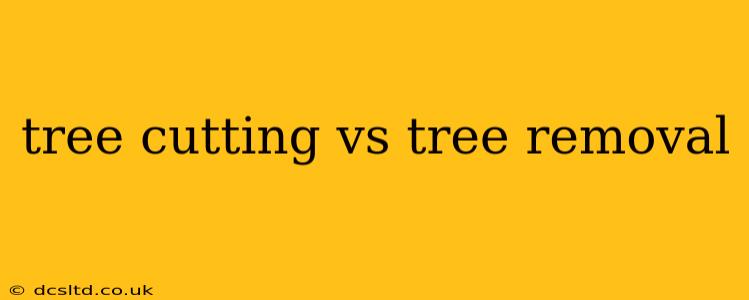Choosing between "tree cutting" and "tree removal" might seem like a simple decision, but understanding the nuances is crucial for ensuring a safe and efficient process. While the terms are often used interchangeably, they represent distinct services with varying levels of complexity and expertise required. This guide will delve into the differences, helping you make the informed choice for your property.
What is Tree Cutting?
Tree cutting typically refers to the selective pruning or trimming of branches. This process focuses on maintaining the tree's health, improving its aesthetic appearance, or removing dead or diseased limbs. Tree cutting might involve removing smaller branches, shaping the crown, or clearing branches that interfere with power lines or structures. This service generally requires less specialized equipment and expertise compared to tree removal.
What is Tree Removal?
Tree removal, on the other hand, is a much more extensive undertaking. It involves the complete felling and removal of an entire tree, including its trunk, roots, and stump. This is necessary when a tree is dead, diseased, poses a safety hazard, or is obstructing construction or other projects. Tree removal requires specialized equipment, techniques, and a high level of skill to ensure the safety of surrounding property and individuals.
What's the Difference? Size Matters!
The primary difference boils down to the scale of the operation. Tree cutting is typically a smaller, less invasive process, while tree removal involves a complete and often more complex removal of the entire tree. The size and condition of the tree heavily influence the choice between these two services. A small, healthy tree needing some minor pruning would warrant tree cutting, whereas a large, decaying tree threatening a house would necessitate tree removal.
What if I need a portion of the tree removed, but not the entire tree?
This situation falls under the umbrella of tree removal, specifically partial tree removal. You may need to remove a significant portion of the tree because of disease, damage, or proximity to structures. While not a complete removal, it still requires specialized skills and equipment, similar to a full tree removal.
How do I know if I need tree cutting or tree removal?
This depends entirely on the specific circumstances:
- Assess the tree's health: Is the tree dead, diseased, or significantly damaged? If so, removal is likely necessary.
- Consider its location: Is the tree close to buildings, power lines, or other structures? If it poses a safety hazard, removal is recommended.
- Evaluate its size: Is the tree small and requires only minor pruning, or is it large and needs significant work? The size directly correlates with the complexity of the job.
- Consult a professional arborist: A qualified arborist can accurately assess the situation and recommend the appropriate course of action. They can identify potential hazards and suggest the best approach for your specific tree and property.
What are the costs associated with each service?
The costs vary significantly based on factors such as tree size, location, accessibility, and the level of complexity involved. Tree cutting is generally less expensive than tree removal, as it requires less time, equipment, and expertise. However, obtaining a precise quote necessitates contacting local tree service providers and having them assess your tree's condition.
By understanding the differences between tree cutting and tree removal, you can ensure that you choose the right service for your needs, leading to a safe and effective outcome for your property and its surrounding environment. Remember to always prioritize safety and consult with experienced professionals for any tree-related work.
